FRIDA KAHLO, tragic and surprising life.
What friends of steemit! Today I want to tell you about Frida Kahlo, do you know her?
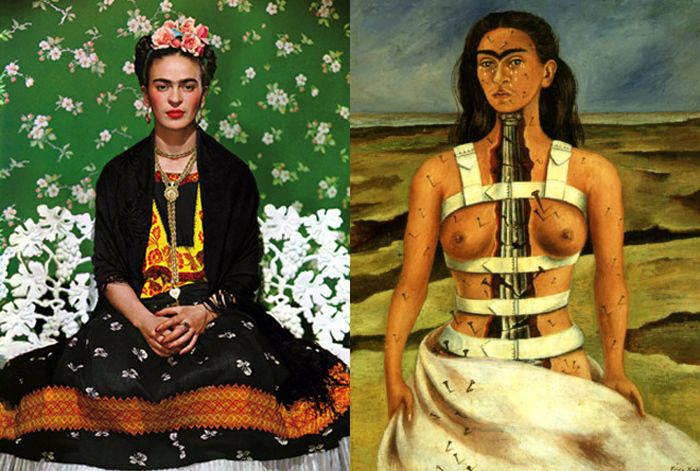
Magdalena Carmen Frida Kahlo or better known as Frida Kahlo; was born in 1907 in the blue house (current museum) Coyoacán-Mexico, in the bosom of a wealthy family and died in 1954.
His father, with whom he was very close, was the official photographer of the architecture of Porfirio Díaz, who, after losing his job in the government, put a photography studio where Frida learns the techniques of how to pose before the cameras, how to take pictures; At that time there was a high school in all of Mexico, in that generation there were 2500 students where 35 were women and one of them was Frida.
In 1925 At 7 o'clock in the evening when the bus on which she was returning to her home in Coyoacán was hit by a tram, she was crushed against a wall and completely destroyed. She was returning home from school, along with Alejandro Gómez Arias, her then boyfriend. In this frightful accident his spine is fractured in three parts, also suffering fractures in two ribs, in the clavicle and three in the pubic bone. Her right leg was fractured in eleven parts, her right foot dislocated, her left shoulder was dislocated and a handrail pierced her from the left hip until it came out through the vagina. In this regard, Frida commented that this would have been the brutal way in which she had lost her virginity. The medicine of her time tormented her with multiple surgical operations (at least 32 throughout her life), plaster corsets and different types, as well as various mechanisms of "stretching".
In her own isolated house at age 18, her mother decides to put a cover over the 4-poster bed a mirror so she can reproduce her image and her father gives her his collection of oil. In his letters and notation an obsession with mirrors and measure of time is noted, having much to do with the time spent in sick bed.
But at 2 months she was already visiting the town, already sufficiently recovered.
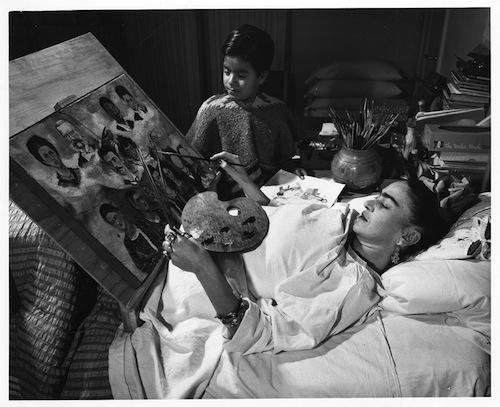
“Nunca pensé en la pintura hasta que tuve que guardar cama a causa de un accidente automovilístico. Me aburría muchísimo ahí en la cama con una escayola de yeso (…), y por eso decidí hacer algo”
One could not talk about Frida without mentioning Diego Rivera, she joined the Communist Party in 1927, a militancy that she shared with Diego, a Mexican painter and muralist (whom he had met at the High School while painting a mural for the house of studies). and in 1929 he married the muralist; marriage has so many ups and downs; Just imagine what it was like to be married to the most famous and most important painter in Mexico and also dedicate yourself to painting, and also taking into account that it was the third marriage of Rivera, who was then 43 years old, while she was just 22 years old. ; Frida gets, for a while, that Rivera abandons his constant love affairs. The marriage caused a surprise in the Mexican society because it was strange that the small and fragile Kahlo could have fallen in love with Rivera, a mature and great man in all aspects; she weighed more than 120 kilos, but for her: "Diego is so kind, so tender, so wise, so sweet, I will bathe him and wash him". 20 years older than her.
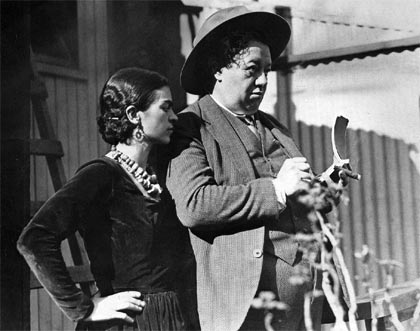
When their parents learned that they were going to get married, they told Frida that Rivera, as well as a communist, was "a fat, fat, fat Brueghel" and that their marriage was the union "of an elephant and a dove".
This stormy and passionate relationship survived infidelities, the pressure of their careers, divorce, a second wedding, Frida's lesbian love affairs, since the handling of her bisexuality at that time when there was very little tolerance for what was different was very difficult, its bad health and your inability to have children. Frida once said: "I suffered two serious accidents in my life ... One in which a tram ran over me and the second was Diego". The tram accident left her physically disabled and Rivera left her emotionally disabled.
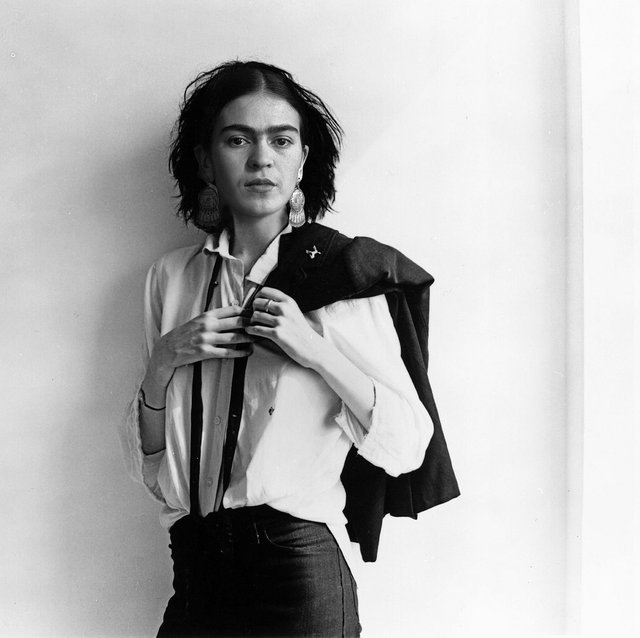
Frida to what he felt like and that is often not accepted.
In 1932, despite her many, Frida became pregnant, but after three months she was convinced to abort the fetus that was badly placed and put her life at risk. Kahlo would try more often, but after the fourth abortion she was convinced that she could never have children, a new pain added to her life. From this first abortion would be born one of his masterpieces Henry Ford Hospital and Frida and abortion (whose complex symbology is known by the explanations of the painter herself) of which her own husband would say: "Frida started working on a series of works unprecedented in the history of art, paintings that exalted the feminine quality of truth, reality, cruelty and grief.Never before has a woman put such a tormented poetry on the canvas like Frida in this time in Detroit." However, these words can not cover the love affair Diego had with several women.
...Tú piensas que me encabroné por lo de Cristina pero hoy he de confesarte que no fue por ella, fue por ti y por mi, primero por mi porque nunca he podido entender ¿qué buscabas, qué buscas, qué te dan y qué te dieron ellas que yo no te di? Por que no nos hagamos pendejos Diego, yo todo lo humanamente posible te lo di y lo sabemos, ahora bien, cómo carajos le haces para conquistar a tanta mujer si estás tan feo hijo de la chingada...
Frida discovered that her husband had a relationship with his little sister, Cristina Kahlo. Although Frida had tolerated Diego's infidelities until then, discovering that she was cheating on her with her own sister plunged her into depression. From then on she made a decision: they would continue together but their marriage would be an open relationship in which each one could have other couples. Frida began to maintain relations not only with men, but also with women, which aroused the jealousy of Diego Rivera, who, like almost all infidels, justifies his behavior but does not tolerate that of others. This is the situation until 1937, when he arrived in Mexico, fleeing from Russia, one of the main figures of the Revolution, Leon Trotsky, who had confronted the leader of the Soviet Union: Josef Stalin, and to save his life he had had to search a place to go into exile. It was the efforts of Diego Rivera, who admired the Russian leader, before the Mexican government, which allowed Trotsky to establish himself in Mexico. Perhaps Kahlo saw there the opportunity to carry out a refined revenge, initiating a loving relationship with Trotsky, whom her husband so much admired.
In 1939 the marriage between Diego and Frida no longer endured more infidelities, so both agree to divorce. One year later, on August 21, 1940, Leon Trotsky was assassinated; As the relationship with Kahlo was known, the police stopped her for questioning and it seems that they did it harshly, holding her back. Finding out about it, Diego Rivera, who at that moment was living in San Francisco making a mural, called her to go and live with him, even though Rivera was then maintaining relations with two other women. Kahlo did not hesitate and flew to San Francisco, and that same year they married for the second time, perhaps because Diego knew that Frida's health was very fragile and needed to be cared for or because in reality, both, despite the infidelities, they loved.
If that love was real or fictitious we do not know it, but it is what she expresses in all her writings and paintings. That's what the brand.
Rivera begins the construction of a house for marriage, inspired by the Aztec temples, which he would call Anahuacalli, built with black volcanic stone. There he intended that his body and Frida's body should rest when they died. While Frida's health was becoming more delicate, the treatments no longer gave the desired effect. In 1950 he entered the hospital in Mexico City, where he stays for a whole year and, in 1953, receives the good news that he is going to celebrate, for the first time in his country, an exhibition of his work in the Art Gallery Contemporary. The doctors forbade her to go, fearing that her weak health could not stand the effort but, knowing how important it was for her to go to the exhibition, Diego arranged to put in the middle of the room, where the exhibition took place, a large bed in the room. that Frida could see her paintings exposed and greet the audience.
Soon after, the gangrene affected his weaker leg, the right one, and they have to amputate it below the knee. Pain and suffering become almost unbearable; Frida came to try to take her own life. A few days before his death he wrote in his diary: "I hope the exit is happy and I hope never to return", she was tired of so many years of unremitting pain.
On July 13, 1954, Frida died at her home in Coyoacán, the famous Blue House where she had been born and lived most of her life and four years later it would become the Frida Kahlo Museum. The coffin of Frida was covered with the flag of the Communist Party, by order of Rivera, and was exhibited in the Palace of Fine Arts before being incinerated. His ashes were deposited in the Blue House.
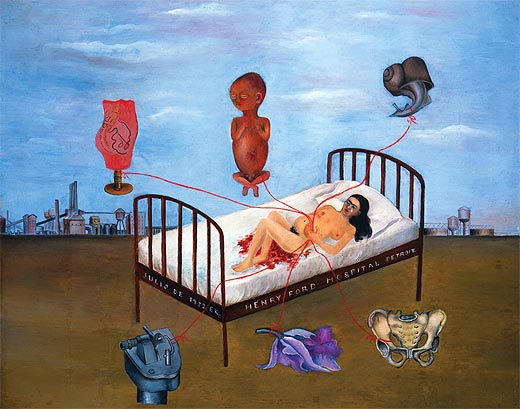
Many things that happened to him were for the benefit of his art and for the pain of his life.
Frida has become a great inspiration as a struggling woman, original, talented and in some way with an immense capacity to love; re-emerging from his pain or making this a fortress. AND YOU THAT THINK??
*Sources:
https://www.ruizhealytimes.com/un-dia-como-hoy/de-1925-frida-kahlo-sufre-accidente-del-cual-nunca-se-recuperara
http://repositorio.uchile.cl/tesis/uchile/2011/fi-armstrong_p/pdfAmont/fi-armstrong_p.pdf
https://culturacolectiva.com/historia/amor-por-siempre-frida-kahlo-y-diego-rivera/
https://www.biografiasyvidas.com/biografia/k/kahlo.htm
http://www.fridakahlofans.com/biobriefsp.html